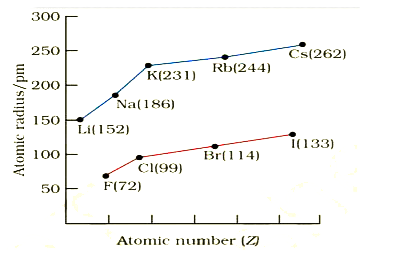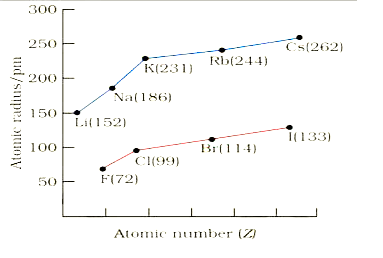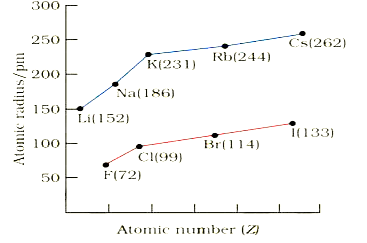Metallic Character
The ability of an atom to donate electrons and form positive ion (cation) is known as electropositivity or metallic character. Down the group, metallic character increases due to increase in atomic size and across the period, from left to right electropositivity decreases due to decrease in atomic size.
Non-Metallic Character
The ability of an atom to accept electrons to form a negative ion (anion) is called non-metallic character or electronegativity. The elements having high electro-negativity have a higher tendency to gain electrons and form anion.Down the group, electronegativity decreases due to increase in atomic size andacross the period, from left to right electronegativity increases due to decreasein atomic size

Identify the reason for the gradual change in electronegativity in halogensdown the group.
Electronegativity increases down the group due to decrease in atomic size.
Electronegativity decreases down the group due to decrease in tendency to lose electrons.
Electronegativity decreases down the group due to increase in atomic radius/ tendency to gain electron decreases.
Electronegativity increases down the group due to increase in forces of attractions between nucleus & valence electrons
The correct Answer is:C
Electronegativity decreases the group due to increase in atomic radius/tendency to gain electron decreases
Topper's Solved these Questions
- BOOK - OSWAL PUBLICATIONCHAPTER - METALS AND NON - METALS EXERCISE - ASSERTION AND REASON7videos
METALS AND NON - METALS
- BOOK - OSWAL PUBLICATIONCHAPTER - DIKSHA QUESTIONS EXERCISE - PERIODIC CLASSIFICATION OF ELEMENTS (MULTIPLE CHOICE QUESTIONS)13videos
DIKSHA QUESTIONS
- BOOK - OSWAL PUBLICATIONCHAPTER - METALS AND NON-METALSEXERCISE - Board corner(Long answer type questions)20videos
METALS AND NON-METALS
Similar Questions
Assertion (A): When a piece of copper metal is added to dilute sulphuric acid, the solution turns blue.
Reason (R): Copper reacts with dilute sulphuric acid to form blue copper (II) sulphate solution.03:42View SolutionThe electronic configuration of an element M is 2,8,4. In modern periodic table, the element M is placed in
02:27View SolutionMetal X is found in nature as its sulphide XS. It is used in the galvanisation of iron articles. Identify the metal X. How will you convert this sulphide ore into the metal? Explain with equations.
01:48View SolutionThe electropositive character of alkali metals decreases with an increase in atomic number.
09:38View SolutionAtoms of metals have only a few electrons in their valence shells while atoms of non-metals generally have more electrons in their valence shells. Metallic character is closely related to atomic radius and ionization enthalpy. Metallic character increases from top to bottom in a group and decreases from left to right in a period. Metallic character is inversely related to electronegativity. Which of the following groups contains metals, non-metals and metalloids-
03:44View SolutionAtoms of metals have only a few electrons in their valence shells while atoms of non-metals generally have more electrons in their valence shells. Metallic character is closely related to atomic radius and ionization enthalpy. Metallic character increases from top to bottom in a group and decreases from left to right in a period. Metallic character is inversely related to electronegativity.
Considering the elements B,C,N and F the correct order of their non-metallic character is06:34View Solution(a) Electropositive nature of the element(s) increases down the group and decreases across the period
(b) Electronegativity of the element decreases down the group and increases across the period
(c) Atomic size increase down the group and decreases across a period (left to right)
(d) Metallic character increases down the group and decreases across a period
On the basis of the above trends of the periodic table, answer the following about the electron with atomic number 3 to 9
(a) Name the most electropositive element among them
(b) Name the most electronegative element
(c) Name of the element with smallest atomic size
(d) Name the element which is a metalloid
(e) Name the element which shows maximum valency.05:30View SolutionThe alkaline earth metals have less electropositive or metallic character as compared to those of alkali metals and their electropositive or metallic character increases down the group. Explain with reasons.
07:11View SolutionMetallic Character
The ability of an atom to donate electrons and form positive ion (cation) is known as electropositivity or metallic character. Down the group, metallic character increases due to increase in atomic size and across the period, from left to right electropositivity decreases due to decrease in atomic size.
Non-Metallic Character
The ability of an atom to accept electrons to form a negative ion (anion) is called non-metallic character or electronegativity. The elements having high electro-negativity have a higher tendency to gain electrons and form anion. Down the group, electronegativity decreases due to increase in atomic size and across the period, from left to right electronegativity increases due to decrease in atomic size

Which of the following correctly represents the decreasing order of metallic character of Alkali metals plotted in the graph?06:19View SolutionMetallic Character The ability of an atom to donate electrons and form positive ion (cation) is known as electropositivity or metallic character. Down the group, metallic character increases due to increase in atomic size and across the period, from left to right electropositivity decreases due to decrease in atomic size. Non-Metallic Character The ability of an atom to accept electrons to form a negative ion (anion) is called non-metallic character or electronegativity. The elements having high electro-negativity have a higher tendency to gain electrons and form anion.Down the group, electronegativity decreases due to increase in atomic size and across the period, from left to right electronegativity increases due to decrease in atomic size Hydrogen is placed along with Alkali metals in the modern periodic table though it shows non-metallic character
05:46View SolutionMetallic Character
The ability of an atom to donate electrons and form positive ion (cation) is known as electropositivity or metallic character. Down the group, metallic character increases due to increase in atomic size and across the period, from left to right electropositivity decreases due to decrease in atomic size.
Non-Metallic Character
The ability of an atom to accept electrons to form a negative ion (anion) is called non-metallic character or electronegativity. The elements having high electro-negativity have a higher tendency to gain electrons and form anion. Down the group, electronegativity decreases due to increase in atomic size and across the period, from left to right electronegativity increases due to decrease in atomic size

Which of the following has highest electronegativity?02:31View SolutionMetallic Character
The ability of an atom to donate electrons and form positive ion (cation) is known as electropositivity or metallic character. Down the group, metallic character increases due to increase in atomic size and across the period, from left to right electropositivity decreases due to decrease in atomic size.
Non-Metallic Character
The ability of an atom to accept electrons to form a negative ion (anion) is called non-metallic character or electronegativity. The elements having high electro-negativity have a higher tendency to gain electrons and form anion.Down the group, electronegativity decreases due to increase in atomic size andacross the period, from left to right electronegativity increases due to decreasein atomic size

Identify the reason for the gradual change in electronegativity in halogensdown the group.03:33View SolutionMetallic Character
The ability of an atom to donate electrons and form positive ion (cation) is known as electropositivity or metallic character. Down the group, metallic character increases due to increase in atomic size and across the period, from left to right electropositivity decreases due to decrease in atomic size.
Non-Metallic Character
The ability of an atom to accept electrons to form a negative ion (anion) is called non-metallic character or electronegativity. The elements having high electro-negativity have a higher tendency to gain electrons and form anion. Down the group, electronegativity decreases due to increase in atomic size and across the period, from left to right electronegativity increases due to decrease in atomic size

Which of the following reason correctly justifies that “Fluorine (72pm) has smaller atomic radius than Lithium (152pm)”?04:49View Solution(a) Electropositive nature of the element(s) increases down the group and decreases across the period
(b) Electronegativity of the element decreases down the group and increases across the period
(c) Atomic size increase down the group and decreases across a period (left to right)
(d) Metallic character increases down the group and decreases across a period
On the basis of the above trends of the periodic table, answer the following about the electron with atomic number 3 to 9
(a) Name the most electropositive element among them
(b) Name the most electronegative element
(c) Name of the element with smallest atomic size
(d) Name the element which is a metalloid
(e) Name the element which shows maximum valency.02:49View SolutionHow do the metallic character and non metallic character vary while moving from left to right in a period? Arriving at a conclusion by assessing the size of atom?
View SolutionFill in the blanks with the appropriate word/s Across a period - Atomic size and metallic character __________ while I.P.. E.A. EN and non-metallic character ____ and nuclear charge _______[ increases/ decreases] Down a group- Atomic size and metallic character _______ while.P, E.A., E.N and non-metallic character _____ and nuclear charge ____________ [increases/decreases]
View Solution

